According to the EPA, indoor air can be up to 100 times more polluted than outside air. Common indoor air pollutants include volatile organic compounds (from cleaning products, paint and building materials), particulate matter (from dust, pollen, pet dander and mold), gasses like carbon monoxide (from heating systems) and nitrogen dioxide (from gas stoves), radon and more.
Unfortunately, most of us spend the majority of our time indoors, where we’re exposed to this polluted air. This exposure can lead to health issues such as headaches, chronic fatigue, dizziness, nausea, dry throat, eye irritation, and even cardiovascular and neurodegenerative diseases.
My family and I live in an older home (built in the 1980s), and a few years ago, we conducted an air quality assessment. That test unsurprisingly revealed less-than-ideal indoor air quality. As a result, we began using an air purification strategy that leverages a combination of whole-house bi-polar ionization and standalone air purifiers.
Unfortunately, most of the air purifiers on the market are either ineffective (because they don’t move enough air to make a dent in the problem), loud, ugly or all of the above.
A few weeks ago, we came across the Jaspr, a comparatively expensive air purifier that’s powerful enough to exchange the air inside a room every five to six minutes. It also looks good and is incredibly quiet. In this review, I’ll explain why I think Jaspr is worth the premium price tag, as well as how it has helped keep our indoor air clean and healthy.
Key takeaways:
- Jaspr eliminates and filters all common air pollutants that are 0.1 microns in size and larger, including odors, chemicals, mold, VOCs, bacteria, viruses, cooking particulates and pet dander.
- It displays the air quality (PM2.5) in real time, so you can see exactly how healthy your indoor air is at any given moment.
- It features high-sensitivity sensors that detect pollution long before you can smell it. It also automatically cranks up the fan speed based on the detected air quality.
- It can filter up to 350 cubic feet of air per minute, cleaning the air in a standard bedroom every five to six minutes.
- It features 360-degree air intake, which means you can place the unit in a corner or close to a wall without sacrificing air scrubbing capacity.
- You can turn off Jaspr’s display at night so it won’t disrupt your sleep.
- It doesn’t increase your EMF exposure because it doesn’t have WiFi or Bluetooth.
- Replacement filters are expensive. Expect to pay between $400 to $600 per year after your initial investment.
Why We’re Concerned About Our Indoor Air Quality
As I discussed in the intro, indoor air is often much more polluted than outside air. Yet most of us spend a lot of time indoors. In other words, we’re constantly exposed to poor air quality, which can lead to health problems beyond respiratory issues and headaches.
For example, a recent study published in Nature Communications concluded that poor air quality can negatively affect brain health and lead to cognitive decline and neurodegenerative diseases.
These are some of the most common sources of indoor air pollution:
- Cleaning products, personal care products, paint, building materials and furniture (all of which release volatile organic compounds, also known as VOCs).
- Dust, pollen, pet dander and mold.
- Gasses like carbon monoxide from heating systems, nitrogen dioxide from gas stoves, and radon (a naturally occurring radioactive gas that can accumulate in homes built on soil with uranium content).
Avoiding exposure to all those pollutants is virtually impossible. While we’ve made every effort to swap out toxic cleaning and personal care products with healthier alternatives, and while we always use no/low-VOC paint, pretty much all modern furniture (at least the items in our price range) has glues and/or stains that can off-gas VOCs.
We also live in an area that experiences high pollen counts twice a year, and which generally has high humidity levels (two things that increase the likelihood of mold growth). Plus, our home is built on soil with uranium content, which means we’re exposed to radon gas.
And to make things worse, we have a German Shepherd that sheds a lot.
All those factors combined meant we had to implement air purification methods to keep our indoor air as healthy as possible.
Unfortunately, improving indoor air quality isn’t as simple as purchasing a $200 air purifier on Amazon and placing it in a central location within your home. That’s because most standalone air purifiers (except, maybe, for commercial air scrubbers) don’t filter enough air to make a dent – especially in comparison to the amount of air your central HVAC system circulates.
Without getting too much into the weeds here, an effective air purification system consists of several components that work together, including your central HVAC system, whole-house filtration and effective standalone units (such as Jaspr). Of course, your specific requirements, indoor air quality and existing health conditions determine the best air purification solution.
How Jaspr Works
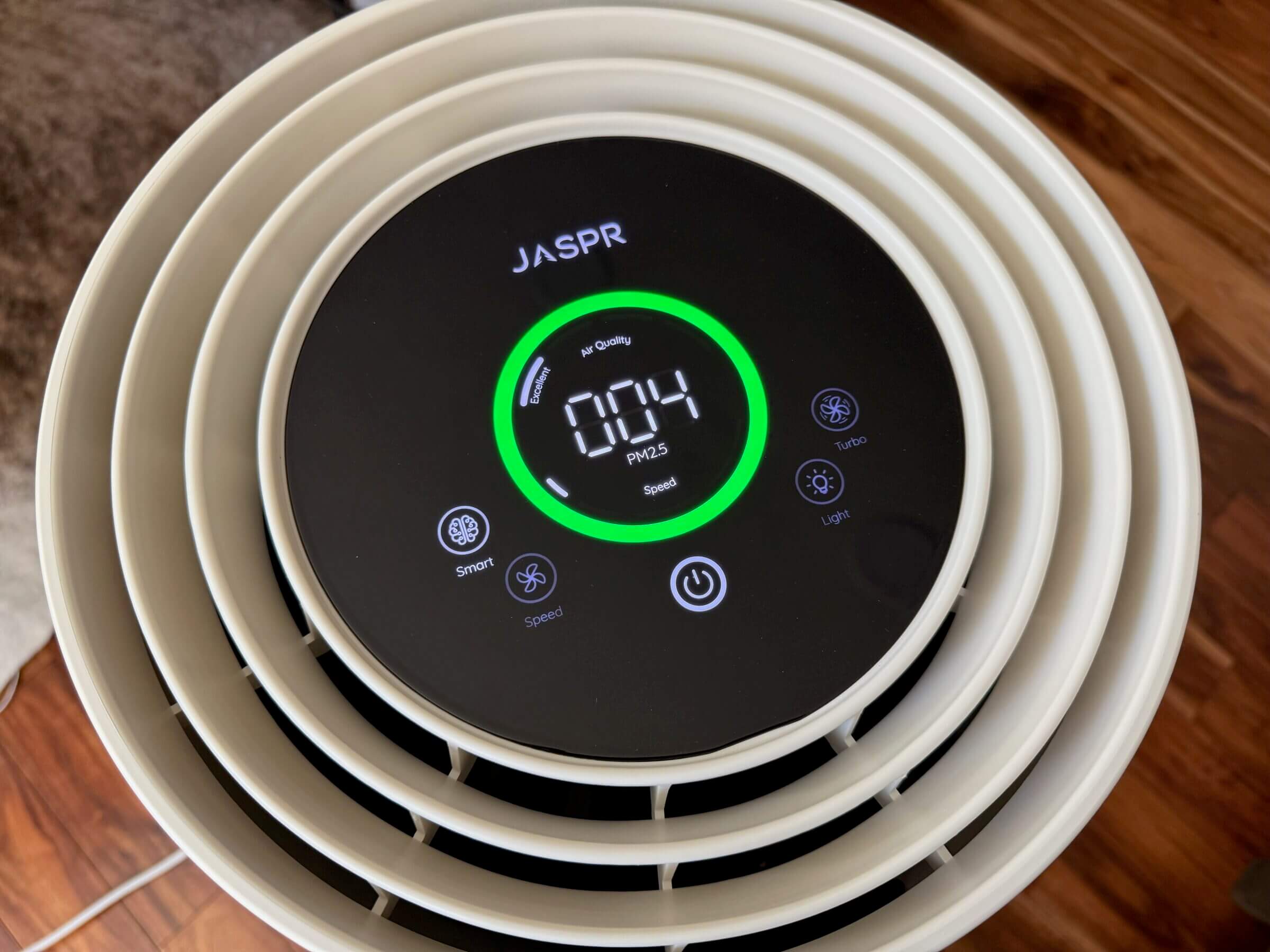
Like most other air purifiers, Jaspr relies on a three-stage filter with an anti-microbial pre-filter, HEPA filter and activated carbon filter. However, unlike the majority of the air purifiers on the market, Jaspr leverages a heavy-duty combo filter that doesn’t have to be washed or vacuumed every few weeks. Instead, you can replace the entire filter every six months.
Despite using only a single (albeit multi-stage) filter, Jaspr can capture 99.9% of ultra-fine particles as small as 0.1 microns. In comparison, other popular air purifiers, such as Wirecutter’s top pick, the Coway Airmega AP-1512HH Mighty, only capture particles 0.3 microns or larger.
The cylindrical shape of Jaspr allows it to pull in air from every direction. That means you can place Jaspr in a corner or against a wall without reducing its filtration capabilities. Most air purifiers on the market have filter inlets on one or two sides (usually on the front or sides), limiting how they can be positioned in a room.
The other big difference between Jaspr and less-expensive air purifiers is the sleeker cold-rolled matte steel enclosure, which is much less reflective than the plastic housing of less-expensive units.
Regarding air quality detection, it’s worth mentioning that Jaspr includes commercial-grade sensors that are incredibly sensitive. I used to have Jaspr in my office, which is tucked away on the other side of our home relative to where the kitchen is. Every time my wife cooks, I can see Jaspr’s air quality indicators turn from green to yellow or red, and I hear the fans crank up because the unit detected odors and gasses from the kitchen. All that usually happens long before I smell any kitchen odors.
Speaking of air quality, Jaspr features a touchscreen display that gives you a real-time air quality rating. Specifically, you can see how many particulates in the 2.5-micron range are in the air. That number is vital because PM2.5 particles are a significant component of air pollution. Long-term exposure to such fine particles can lead to health problems, including respiratory issues, heart disease, aggravation of lung diseases and even premature death in individuals with pre-existing heart or lung conditions.
Aside from viewing the air quality in real-time, you can also use the touchscreen to turn the unit on and off, change the fan speed (four speeds from low to high), turn off the display (to avoid disrupting your sleep if you use Jaspr in your bedroom), and turn on turbo and smart mode. The latter controls the fan speed based on air quality.
Something that I really like about Jaspr is that it’s quiet unless you crank up the fan speed. Depending on the latter, sound levels range from 33 to 58 dB. If you’re a fan of white noise for sleeping as much as we are, I recommend running Jaspr on level two with the screen turned off. With those settings, the unit cycles the air in your bedroom approximately once every 10 minutes, which can dramatically improve the air quality of your bedroom.
My Experience Using Jaspr
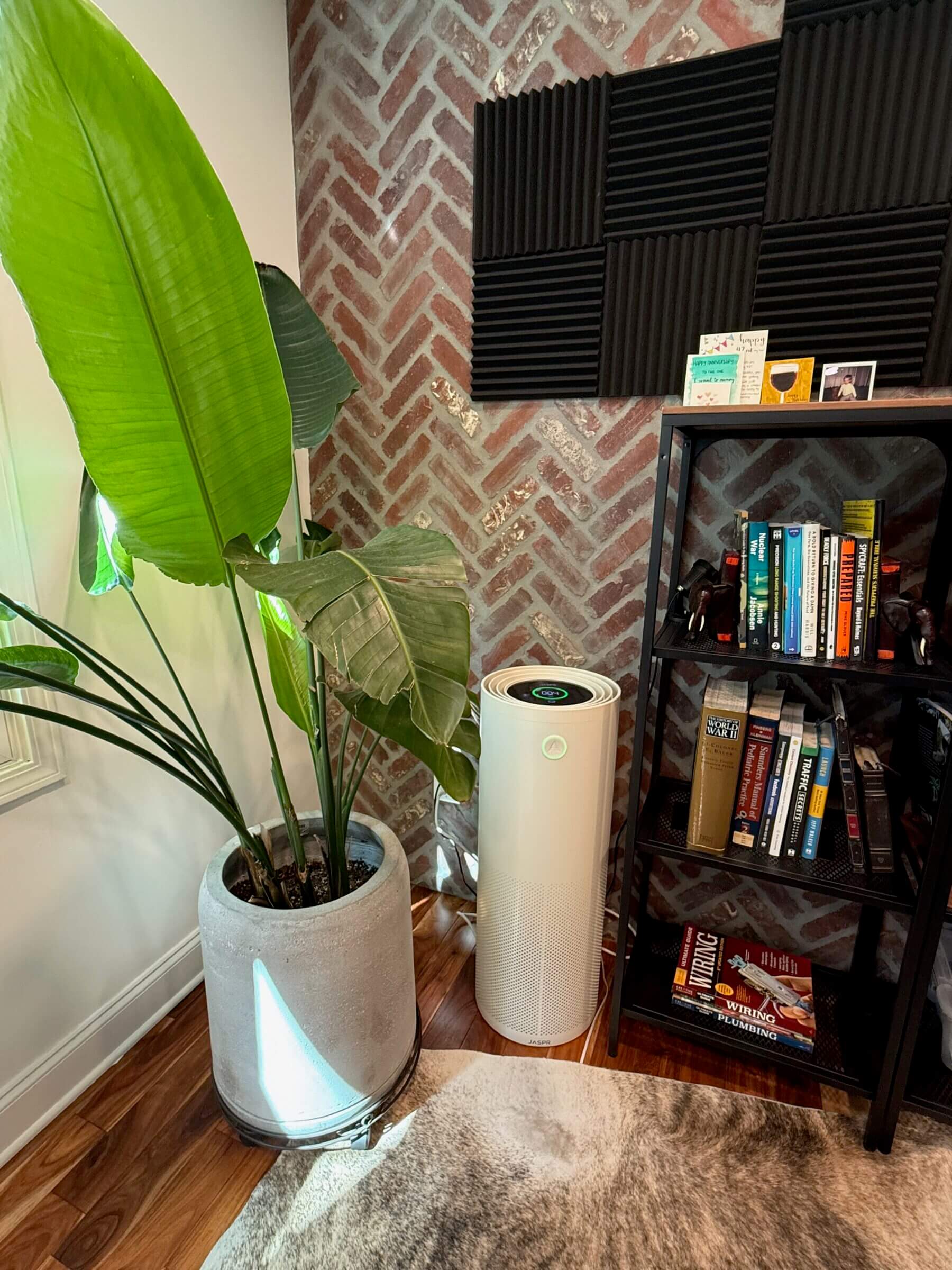
I love Jaspr because it contributes to healthier indoor air without being noisy or an eyesore. In fact, it blends so well into the environment (in part, thanks to its non-reflective housing) that you barely notice it’s there. At the same time, I can quickly glance at Jaspr’s display to get an immediate indication of the current air quality.
In addition to displaying the specific particulate matter, Jaspr also indicates air quality using a traffic light system: green indicates excellent air quality, orange indicates moderate or poor air quality, and red indicates critical air quality.
As I mentioned earlier in this article, I used to have Jaspr in my office, primarily so that I could interact with it while testing it for this review. But when my wife came into my office the other day and commented on how sleek it looked, I told her we could use it instead of our white noise machine. She immediately agreed, and since then, the unit has been in our bedroom, doubling as an air purifier and white noise machine.
I usually describe in great detail how I use the gadgets I review, but Jaspr is different. It sits quietly in a corner and occasionally turns up its fans when it detects less-than-optimal air quality levels. That’s it. The only interaction we have with Jaspr is when we use the touchscreen to turn off the display and increase the fan speed (effectively turning it into a white noise machine) before going to bed, and switching the display and “Smart” mode back on in the morning to allow the unit to regulate the fan speed based on current air quality levels.

One notable thing that’s missing from the display is a filter change indicator, which I have gotten used to from other air purifiers. However, there isn’t a reliable mechanism to judge a filter’s remaining lifespan, so Jaspr recommends replacing it every six months. I just added a “replace filter” reminder to the list of existing reminders I share with my wife.
On a side note, you can sign up for a filter subscription to receive replacement filters automatically every six months and unlock a lifetime warranty.
How Jaspr Compares to Competing Products
| Jaspr | AirDoctor | Coway Airmega | HypoAir | Dyson | |
|---|---|---|---|---|---|
| Clear Air Delivery Rate (CADR) | 350 CFM | 556 CFM | 416 CFM | 320 CFM | 185 CFM |
| Filtration Limitations | None | Nitrogen Dioxide (NO2) | Formaldehyde, Nitrogen Dioxide (NO2) | None | None |
| Coverage (sq. ft.) | 1,600 | 4,172 | 874 | 500 | 1,076 |
| MSRP | $1,200 | $1,000 | $210 | $600 | $1,100 |
| Annual Filter Cost | $200-300 | $410 | $48-65 | $140 | $280 |
Based on my experience with different air purification solutions, Jaspr is in a class of its own.
That doesn’t mean there aren’t other air purifiers on the market that offer good filtration capabilities, but they’re usually lacking in one or more areas. To illustrate what I mean, let’s compare Jaspr to some popular air purifiers on the market, including models from Coway, AirDoctor, Dyson and HypoAir.
Jaspr vs. Coway Airmega AP-1512HH Mighty

The Coway Airmega AP-1512HH Mighty has been Wirecutter’s #1 pick for years, and it’s a reasonable device for single rooms — especially considering that its clean air delivery rate (CADR) is slightly higher than Jaspr’s, which means it takes a little less time to change the air in a given room.
One factor that makes the Coway Airmega less effective than Jaspr is the position of the air inlet. While Jaspr can suck air into its cylindrical filter from every direction, Coway has a single inlet at the front. That also limits how you can position the unit.
Coway also requires regular cleaning of the prefilter, which adds to the maintenance effort. From an aesthetic perspective, the Coway unit is made of reflective plastic, whereas Jaspr is made of non-reflective steel.
Since I brought up Wirecutter, I also wanted to point out that their review team doesn’t appear to know about the nuances of ionization. Their article claims that ionization produces ozone, but that’s certainly not true about state-of-the-art bi-polar ionization technology such as the one from HypoAir we use in our home.
I also consider how they set up their test environment flawed because they positioned the air purifier in the center of the room. Nobody does that. It’s more likely that people tuck air purifiers away in a corner, which limits their effectiveness, especially with units that don’t have a 360-degree air inlet (like Jaspr).
Of course, the Coway Airmega costs only a fraction of what Jaspr costs, and that has to be an essential consideration, especially if you’re on a budget. In other words, if you don’t care about the aesthetics, power consumption and maintenance effort, you could purchase five Coway units for what a single Jaspr costs.
Jaspr vs. AirDoctor 5500

The AirDoctor 5500 is an excellent and powerful air purifier that performs comparably to Jaspr at an equivalent cost.
However, unlike the Jaspr, the AirDoctor requires regular filter cleaning and does not have a 360-degree air inlet. As a result, you’re limited in how you can position the AirDoctor (you need a foot of space on each side of the unit for proper airflow).
The AirDoctor is also made of cheap ABS plastic, which is super reflective and doesn’t look good, in my opinion. Plus, the production of ABS plastic produces 50-200% more CO2 than the production of rolled steel, which is an environmental factor you might want to consider.
Despite the added maintenance effort, there are advantages to having separate pre, HEPA and activated charcoal filters (instead of a combo filter like Jaspr). Specifically, you can replace the individual filters at different intervals, saving money in the long run. Activated charcoal filters can last between six to 12 months (depending on your indoor quality), and HEPA filters can retain their effectiveness for 12-24 months. On the flip side, Jaspr’s combo filter must be replaced every six months (again, depending on air quality).
If the AirDoctor 5500 were a few hundred dollars cheaper, I’d consider it a serious alternative to Jaspr. But considering that they cost the same, I’d go with Jaspr.
Jaspr vs. HypoAir Snowflake
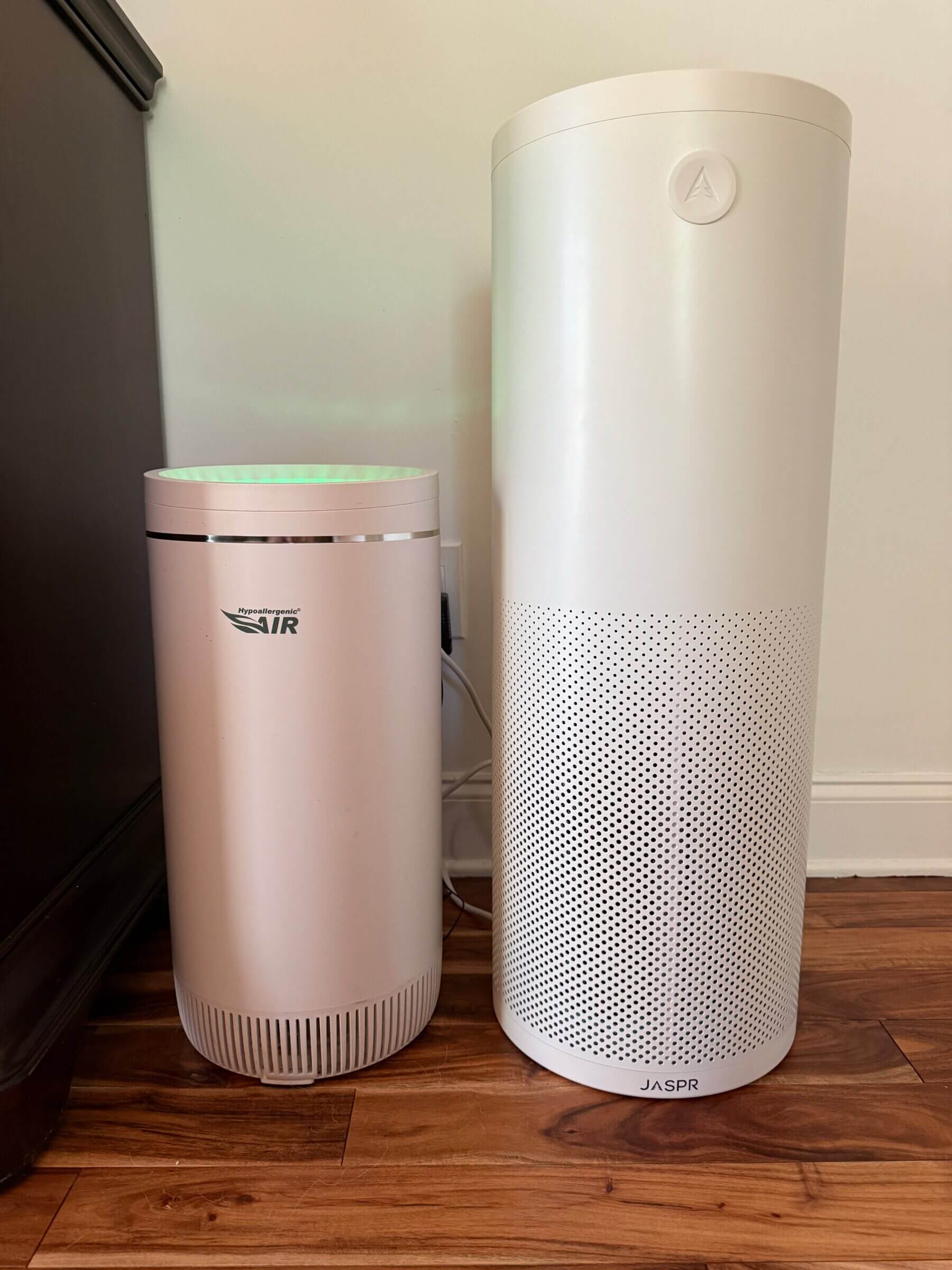
We’ve used the HypoAir Snowflake in our bedroom for several years and have zero complaints about the unit. It costs only half of what Jaspr retails for, but it’s also less powerful. At its highest setting, the HypoAir Snowflake delivers about the same clean air delivery rate (CADR) of Jaspr. Still, it features a clinical-grade H13 HEPA filter in combination with on-demand UV and bi-polar ionization. (The latter only kicks in when the Snowflake detects very poor air quality.)
Like the Jaspr, the Snowflake has a 360-degree air intake with a single filter that must be replaced every six months. Since we moved Jaspr into our bedroom, the HypoAir Snowflake has found a new home in my office.
The problem with the Snowflake is that it’s often out of stock, so you might not be able to get one at all.
Jaspr vs. Dyson Air Purifiers
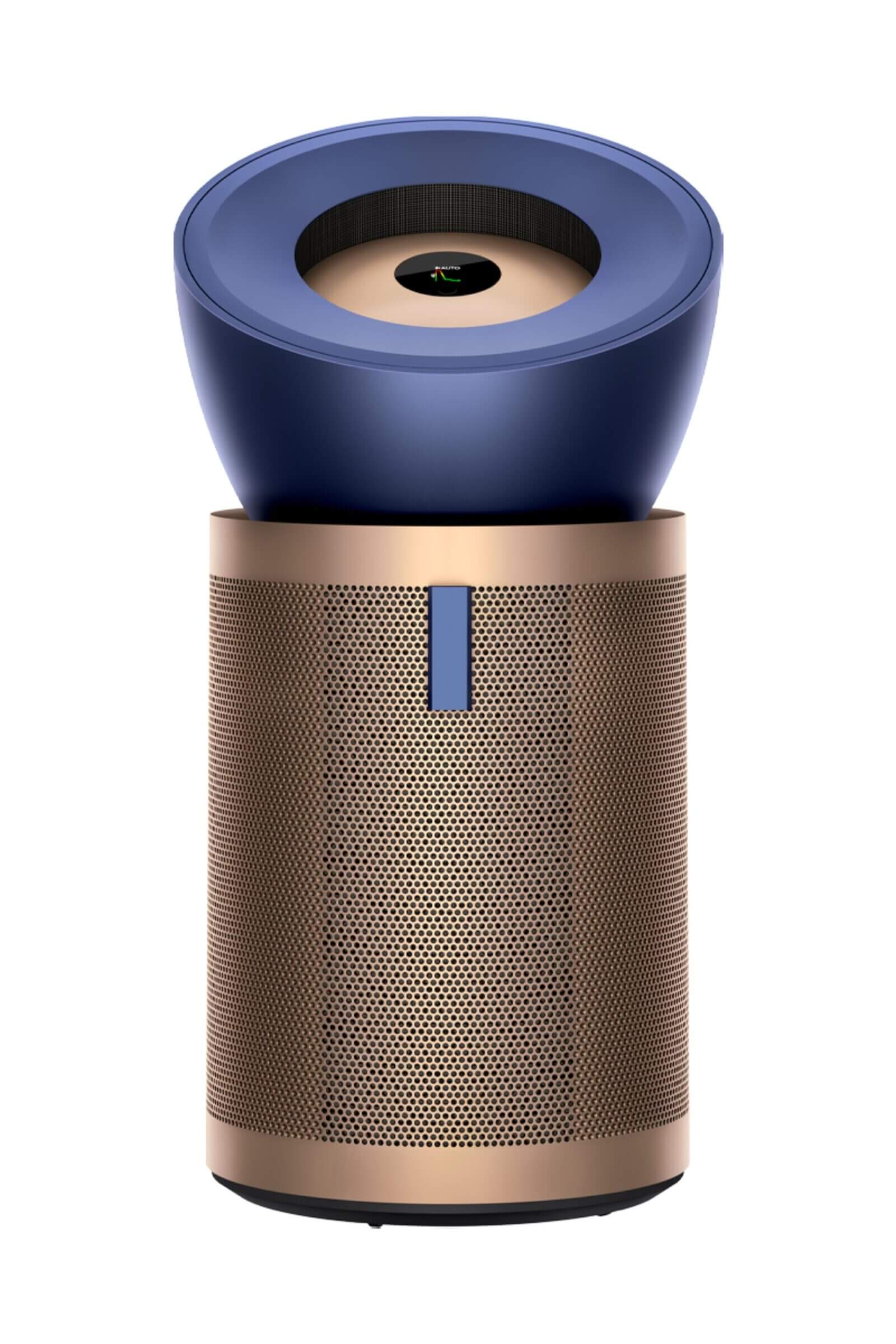
We’ve owned several overpriced Dyson products over the years, and they’ve all disappointed us somehow. Regarding Dyson’s air purifiers, I’m concerned about their incredibly low clean air delivery rate (for the price of the units).
The truth is that Dyson doesn’t publish any CADR numbers, but based on their airflow ratings and some math, the CADR of their most expensive unit (the Dyson Purifier Big+Quiet Formaldehyde BP04) is 184 CFM.
If you’re wondering about the ability to remove formaldehyde (a volatile organic compound), both the Dyson BP04 and Jaspr can do that.
However, considering the Dyson BO04 retails for $1,100, it would not be my first choice.
Jasper Pro vs. HypoAir BiPolar
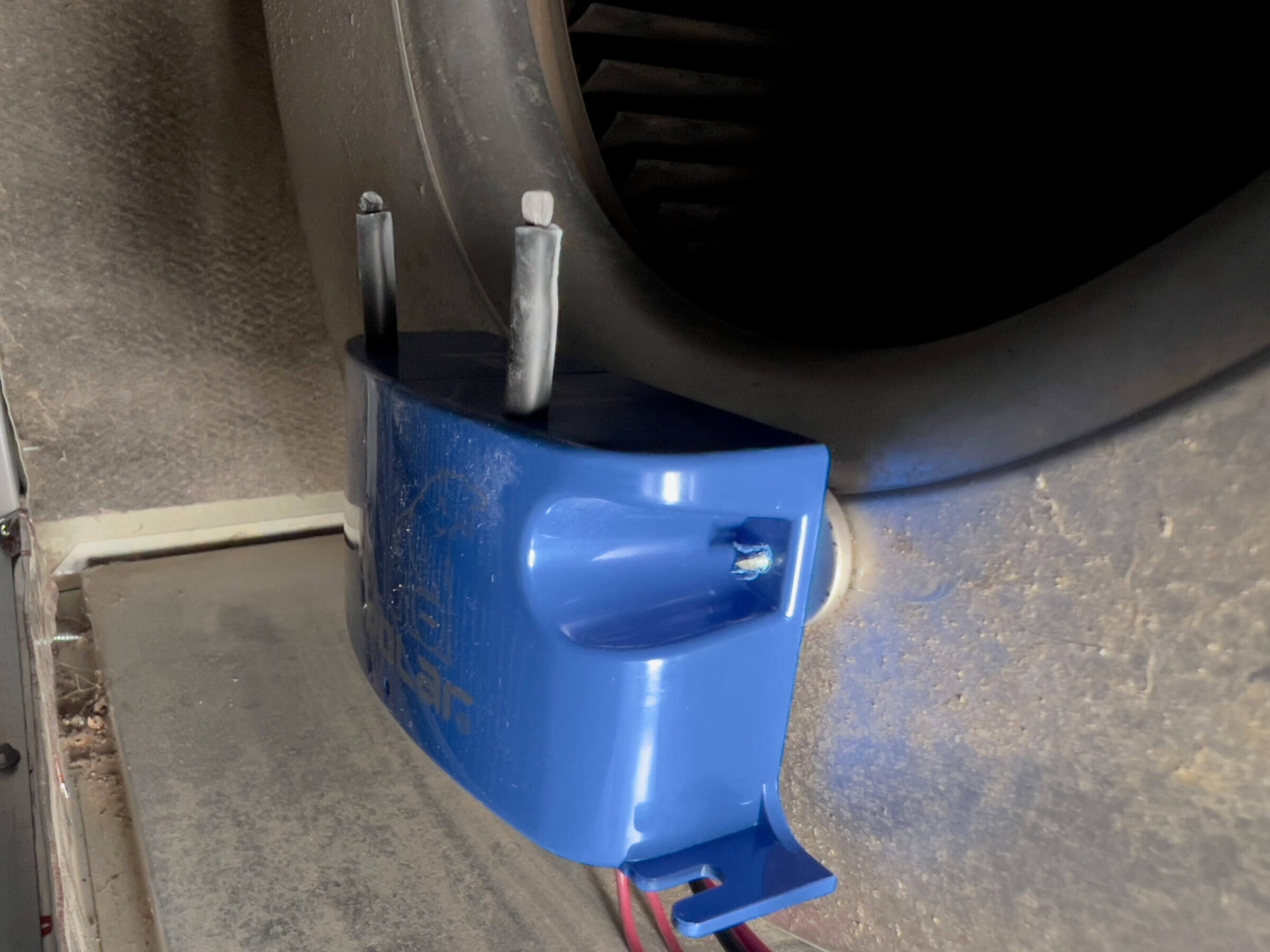
If you’ve been following me for a while, you might remember that we also rely on bi-polar ionization technology from HypoAir to purify the air in our entire home. However, it’s worth noting that whole-house bi-polar ionization plays a different role than air filtration.
In other words, our whole-home ionizer doesn’t filter the air. Instead, it produces charged particles (ions) that deactivate certain pathogens (such as viruses, bacteria and mold) while causing other pollutants (like dust) to clump up and become large enough for the HVAC filter or Jaspr to remove them from the air.
The significant advantage of a whole-home ionizer is that it turns the central HVAC system into a delivery vehicle for charged particles that then do their job in every room of the house. To achieve optimal air sanitation from the bipolar ionizer, we run the blower fan for 45 minutes every hour, even when the AC compressor or the furnace isn’t running.
By combining bipolar ionization and mechanical air filtration, we tackle air quality issues from different angles, which is much more effective than using only one solution.
Pricing (Is It Worth $1,200?)
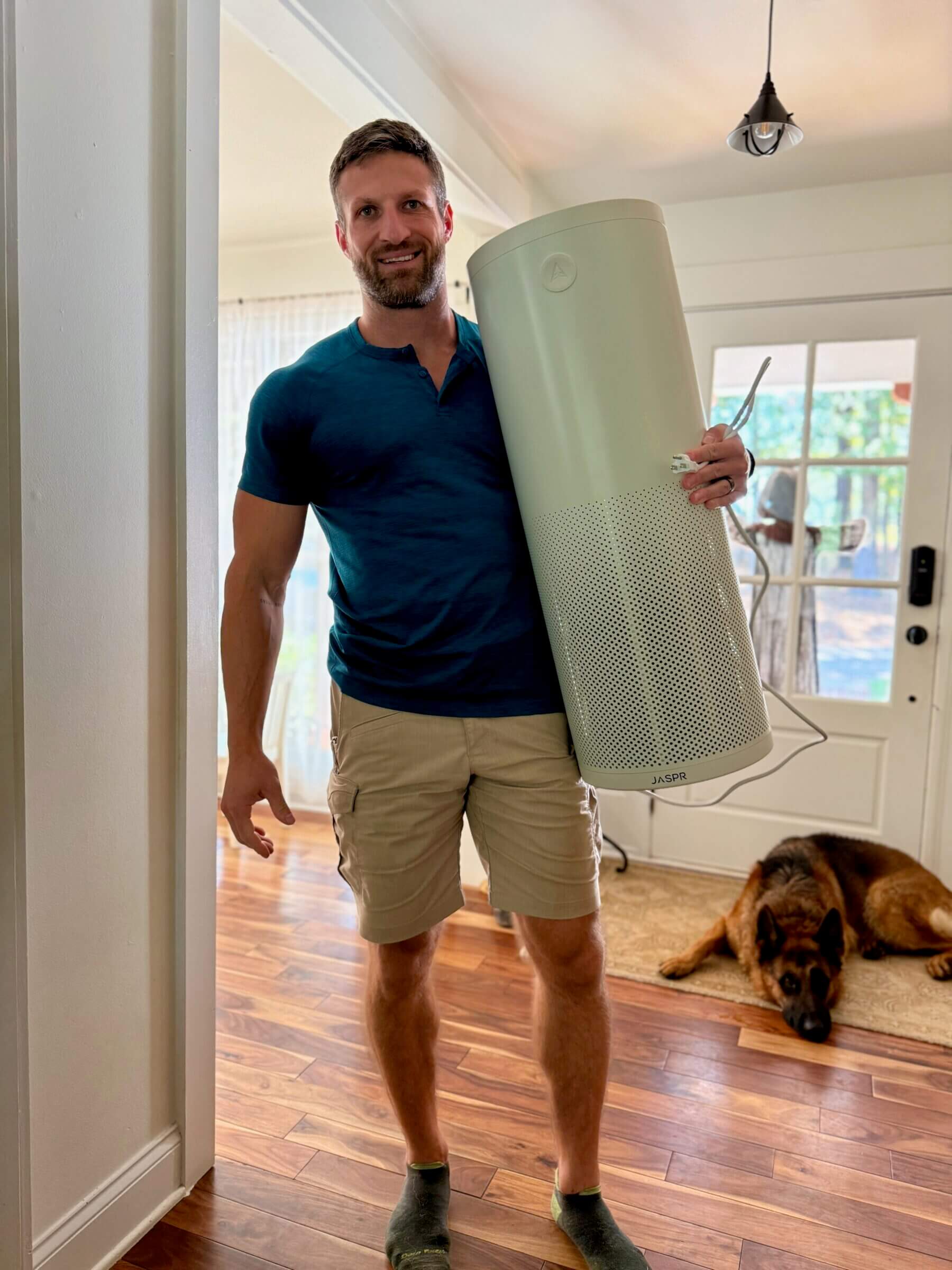
So the $1,200 dollar question is whether Jaspr is worth the price.
As with many things, you get what you pay for. The unit is highly effective at purifying indoor air, looks great, and is built like a tank. So if you value top-notch performance, outstanding aesthetics and virtually zero maintenance, Jaspr is a no-brainer.
But even if you can stomach the initial price tag, you need to consider whether you’re comfortable with the annual cost associated with filter replacements. The one-time price for a new filter is a whopping $300, which means you’ll have to shell out $600 per year for replacement filters. In other words, you could purchase a new Jaspr every two years and not spend more than you’d spend on filters. That’s nuts.
Of course, you can sign up for a filter subscription, which knocks $200 off the initial purchase price of the unit and unlocks a lifetime warranty. The subscription lowers the annual filter replacement cost to $400. That’s still a big chunk of money, but certainly more palatable.
Ultimately, whether or not Jaspr is worth its asking price depends on your current state of health and the environment you live in.
If you live in an area where air quality is extremely poor (e.g., due to regular wildfires), investing in a high-end air purifier like Jaspr is a no-brainer. On the flip side, if you live in a new home constructed using non-toxic building materials somewhere in the mountains with pristine outdoor air, you probably don’t need to commit to spending this much money.
If you do decide to buy Jaspr, use code MICHAELKUMMER to get 10% off the purchase price. If you were wondering, Jaspr is not available on Amazon.
Miscellaneous Notes
Operating Jaspr 24/7 costs approximately 21 cents per day here in Georgia (based on an average electricity cost of 12 cents per kWh). That’s just $6 per month to cover up to 1,600 square feet with an eight-foot ceiling.
While Jaspr weighs 25 pounds (I told you it’s built like a tank), it’s relatively easy to move around. For example, when relocating the unit from my office to our bedroom, I just “bear-hugged” it and carried it over.
Jaspr Review: Final Verdict

Jaspr isn’t cheap, but it’s the most effective residential air purifier I’ve encountered. The only units that are likely more effective at removing pollutants, including wildfire smoke, smog and mold from indoor air, are commercial air scrubbers. But those are ugly and loud, and I don’t know many people who would enjoy using those machines for extended periods unless necessary (e.g., after a wildfire).
Jaspr delivers outstanding air purification performance in a sleek package that doesn’t stick out like a sore thumb. Of course, all standalone air purification systems are limited in how much air they can process. In other words, if you have air quality issues and live in a large home with multiple rooms, you’ll likely need several units to cover your entire living space.
It’s probably also worthwhile combining air purifiers like Jaspr with whole-house purification systems, including activated charcoal HVAC filters and bi-polar ionization. We’ve been doing this, and it’s made a dramatic difference in our indoor air quality.

Michael Kummer is a healthy living enthusiast and CrossFit athlete whose goal is to help people achieve optimal health by bridging the gap between ancestral living and the demands of modern society.
Medical Disclaimer
The information shared on this blog is for educational purposes only, is not a substitute for the advice of medical doctors or registered dieticians (which we are not) and should not be used to prevent, diagnose, or treat any condition. Consult with a physician before starting a fitness regimen, adding supplements to your diet, or making other changes that may affect your medications, treatment plan or overall health. MichaelKummer.com and its owner MK Media Group, LLC are not liable for how you use and implement the information shared here, which is based on the opinions of the authors formed after engaging in personal use and research. We recommend products, services, or programs and are sometimes compensated for doing so as affiliates. Please read our Terms and Conditions for further information, including our privacy policy.
